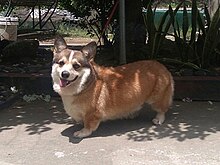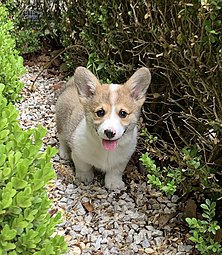Pembroke Welsh Corgi
| Pembroke Welsh Corgi | |||||||||||||||||||||||||||||
|---|---|---|---|---|---|---|---|---|---|---|---|---|---|---|---|---|---|---|---|---|---|---|---|---|---|---|---|---|---|
 | |||||||||||||||||||||||||||||
| Common nicknames | Corgi, Welsh Corgi, Pembroke | ||||||||||||||||||||||||||||
| Origin | Wales | ||||||||||||||||||||||||||||
| |||||||||||||||||||||||||||||
| |||||||||||||||||||||||||||||
| Dog(domestic dog) | |||||||||||||||||||||||||||||

ThePembroke Welsh Corgi(/ˈkɔːrɡi/;Welshfor "dwarf dog"[a]) is acattleherding dogbreedthat originated inPembrokeshire,Wales.[1]It is one of two breeds known as aWelsh Corgi,the other being theCardigan Welsh Corgi.Pembroke Welsh Corgis descended from theSpitzfamily of dogs.
Pembroke Welsh Corgis are famous as the preferred breed ofQueen Elizabeth II,who owned more than 30Royal corgisduring her reign.[2]Although these dogs have been favoured by British royalty for more than seventy years, among the British public they have recently fallen into decline in terms of popularity and demand.[3]However, they remain very popular in the United States. Cities such as New York, Boston, Los Angeles, and San Francisco hold annual "Corgi Meetups" in which hundreds of dogs and their owners congregate to spend the day.[4]
The Pembroke Welsh Corgi has been ranked 11th inStanley Coren'sThe Intelligence of Dogs,which states that the breed is considered an excellent working dog. Pembroke Welsh Corgis were ranked 11th most popular breed of dog in 2020 according to the American Kennel Club.[5]
Description[edit]
Appearance[edit]
The Pembroke Welsh Corgi has erect ears that are in proportion to the equilateral triangle of the head. The breed standard indicates that the ears should be firm, medium in size, and tapered slightly to a rounded point. The head should be "fox-like" in shape and appearance. Pembroke Welsh Corgis differ from theCardigan Welsh Corgiby being shorter in length, having smaller ears, and being slightly straighter of leg.[6]The Pembroke Welsh Corgi has somewhat lighter markings on each side of thewitherscaused by changes in the thickness, length, and direction of hair growth.[7]
Being a double-coated dog, the Pembroke Welsh Corgi sheds heavily all year around, with peaks in the spring and autumn. With regular brushing, their coat is fairly easy to maintain, as well as naturally water- and dirt repellent (at the exception of "fluffies" )[clarification needed].Intact females are also known to shed during heat.[8]
Breed faults exist and should not be bred on purpose; such as corgis with a very long and thinner coat coming from a recessive gene[9]and red coats present with a bluish cast which have a diluted colour.

While some outlying Pembroke Welsh Corgis are born with their tail naturally short, the majority often have their tailsdockedbetween 2–5 days old due to historical tradition or to conform to the Breed Standard.[10]Artificial docking was not needed for the dog to do its job as a herding dog in the United Kingdom as many claim (since Cardigan Welsh corgis were also herding dogs but never docked) but rather because a non-herding dog was considered a luxury under tax law and attracted a tax, so to demonstrate that their dogs were herding dogs, owners had to ensure the dogs had docked tails.[citation needed]The Kennel Club,[11]the United Kennel Club,[12]and the FCI allow intact tails in Conformation shows. The AKC Standard states tails should be docked no longer than 2 inches (5 cm). In many countries including the United Kingdom, docking has been deemed illegal.[13]
Temperament[edit]


Pembroke Welsh Corgis love to be involved in the family, and tend to follow wherever their owners go. They have a great desire to please their owners, thus making them eager to learn and train. The dogs can also be challenging to train due to their working background, stubbornness and intelligence – they were ranked as the eleventh mostintelligent dogin Stanley Coren'sThe Intelligence of Dogs.Besides herding, they also function as watchdogs due to their alertness and tendency to bark, which can be aggravated if they are not stimulated adequately. Most Pembrokes will seek the attention of everyone they meet and behave well around children and other pets. It is important to socialise this breed with other animals, adults, and children when they are very young to avoid any anti-social behaviour or aggression later in life. Due to their herding and – for some – prey instinct, they love to chase anything that moves, so it is best to keep them inside fenced areas. The herding instinct will also cause some younger Pembrokes to nip at their owners' ankles as this is what they were bred to do with cattle.[14]
Health[edit]

A 2024 UK study found a life expectancy of 13.2 years for the breed compared to an average of 12.7 for purebreeds and 12 forcrossbreeds.[15] Pembroke Welsh Corgis areachondroplastic,meaning they are a "true dwarf" breed. As such, their stature and build can lead to certain non-inherited health conditions, but genetic issues should also be considered. Commonly, Pembrokes can suffer frommonorchidism,Von Willebrand's disease,hip dysplasia,degenerative myelopathy(DM), and inherited eye problems such asprogressive retinal atrophy.Genetic testingis available for Pembroke Welsh Corgis to avoid these issues and enhance the genetic health pool.[16] Pembrokes are also prone toobesitygiven a robust appetite, characteristic of herding group breeds.[17]
History[edit]

The Pembroke Welsh Corgi lineage has been traced back as far as AD 1107.[1][18]It is said that Flemish weavers brought the dogs with them as they travelled to reside in Wales. Some popular stories give Corgis a creation myth connected tofairies.One story states that two children were running through a forest and stumbled upon the funeral of a fairy. The mourning fairies gave the two children two small corgi puppies and the children took them home, thus giving the breed popularity.[citation needed]Stories also state that Corgis played the role of war horses for fairies before they became herding dogs for humans. At the base of the haunches of Corgis, there is a line of slightly rougher fur called the fairy saddle. Rather than Welsh lore, this may be a modern myth sparked by corgi breeders of the 1940s.[19]
Pembrokes and Cardigans first appeared together in 1925 when they were shown under the rules of The Kennel Club in Britain.[20]The Corgi Club was founded in December 1925 inCarmarthen,Carmarthenshire.[20]It is reported that the local members favoured the Pembroke breed, so a club for Cardigan enthusiasts was founded a year or so later.[20]Both groups have worked hard to ensure the appearance and type of breed are standardised through careful selective breeding.[20]Pembrokes and Cardigans were officially recognised by the Kennel Club in 1928 and were initially categorised together under the single heading of Welsh Corgis before the two breeds were recognised as separate and distinct in 1934.[20]

Pembroke Welsh Corgis are becoming more popular in theUnited Statesand rank 20th (24th) inAmerican Kennel Clubregistrations,[21]as of 2015 (2012). However, corgis are now listed as a "vulnerable" breed in the United Kingdom; the decline has been said to be due to a 2007 ban on tail-docking (the practice of cutting off the animal's tail) in the UK, as well as the lack of breeders in the UK[22]In 2009, the corgi was added to The Kennel Club's "At Watch" list of British breeds when annual registrations numbered between 300 and 450.[23]In 2014, the breed was put on the Club's "Vulnerable Native Breeds" list when registrations dropped under 300.[23]In 2018, the breed came off the "At-Risk" list with 456 puppies registered in December 2017.[23]The Kennel Club has credited the renewed interest in the breed to the popularNetflixtelevision series,The Crown,[23]and others.[24]The Pembroke Welsh Corgi has also appeared in the American televisionBrooklyn Nine-Nineas the pet dog ofCaptain Raymond HoltandKevin M. Coznerand is shown to be extremely loyal.Ein,a Corgi with human-level intelligence, is one of the 5 main characters in the TV showCowboy Bebop.
Activities[edit]
Pembroke Welsh Corgis can compete indog agilitytrials,obedience,showmanship,flyball,tracking,andherdingevents. Herding instincts and trainability can be measured at noncompetitive herding tests.[25]Corgis, despite their dwarfism giving the illusion of small slow legs, can reach up to 25 mph if they are healthy and fit. This is because Corgis tend to use more upper body strength to run than most dogs, giving them enhanced abilities with such activities as agility and herding and racing.
Royal corgis[edit]
At a young age, the Queen's passion for this breed started when her father,King George VI,brought home their first royal corgi who was later named Dookie.[26]The Queen ceased breeding corgis around 2012 so as not to leave any behind after she died; her last corgi, Willow, died in April 2018.[27]She was gifted two new corgi pups by her family in 2021.[28][29]
On 3 April 2019, the filmThe Queen's Corgiwas released.[30]
See also[edit]
References[edit]
- ^abWheeler, Jill C. (2010).Welsh Corgis.ABDO. p. 6.ISBN978-1-61613-641-3.
- ^"Queen's Diamond Jubilee: Just how many dogs does she own?".Christian Science Monitor.2 June 2012.Retrieved28 January2013.
- ^The Kennel Club."Vulnerable Native Breeds".The Kennel Club.Retrieved3 July2016.
- ^Ho, Eric (17 November 2017)."How I Became The Leader Of The New York City Corgi Meet Ups".Medium.Retrieved19 November2019.
- ^"THE MOST POPULAR DOG BREEDS OF 2020".Retrieved19 October2020.
- ^Richard G. Beauchamp (1999).Welsh Corgis: Pembroke and Cardigan: Everything about Purchase, Care, Nutrition, Grooming, Behavior, and Training.Barron's Educational Series. p.15.ISBN978-0-7641-0557-9.
- ^Debra M. Eldredge, DVM (25 February 2009).Pembroke Welsh Corgi: Your Happy Healthy Pet, with DVD.John Wiley & Sons. p. 17.ISBN978-0-470-44364-4.
- ^Debra M. Eldredge, DVM (25 February 2009).Pembroke Welsh Corgi: Your Happy Healthy Pet, with DVD.John Wiley & Sons. p. 70.ISBN978-0-470-44364-4.
- ^Eldredge, Debra M (2009).Pembroke Welsh Corgi: Your Happy Healthy Pet, with DVD.John Wiley & Sons. p. 17.ISBN978-0-470-44364-4.
- ^"PWCCA Standard of Perfection".Archived fromthe originalon 18 January 2015.Retrieved20 January2015.
- ^Kennel Clun."Pembroke Welsh Corg".Archived fromthe originalon 14 June 2012.Retrieved28 January2013.
- ^United Kennel Club."Pembroke Welsh Corgi".Retrieved28 January2013.
- ^Cathy Lambert.Getting to Know Poodles: A Guide to Choosing and Owning a Poodle.Animalinfo Publications. p. 15.ISBN978-1-921537-06-6.
- ^"Get to know the Pembroke Welsh Corgi".Archived fromthe originalon 2 August 2009.Retrieved28 January2013.
- ^McMillan, Kirsten M.; Bielby, Jon; Williams, Carys L.; Upjohn, Melissa M.; Casey, Rachel A.; Christley, Robert M. (1 February 2024)."Longevity of companion dog breeds: those at risk from early death".Scientific Reports.14(1). Springer Science and Business Media LLC: 531.Bibcode:2024NatSR..14..531M.doi:10.1038/s41598-023-50458-w.ISSN2045-2322.PMC10834484.PMID38302530.
- ^"From the Genetics Committee of the Pembroke Welsh Corgi Club of America, Inc".Archived fromthe originalon 16 January 2013.Retrieved28 January2013.
- ^E. Hywel Burton (18 October 2011).Pembroke Welsh Corgi.Kennel Club Books. p. 116.ISBN978-1-59378-890-2.
- ^"Pembroke Welsh Corgi - HISTORY".Archived fromthe originalon 29 December 2014.Retrieved28 January2013.
- ^Zeller, Jon (7 December 2021)."The Corgi Care Guide: Personality, History, Food, and More".The Farmer's Dog Digest.
- ^abcdeDebra M. Eldredge (27 January 2009).Pembroke Welsh Corgi: Your Happy Healthy Pet, with DVD.John Wiley and Sons. pp. 21–.ISBN978-0-470-39061-0.Retrieved10 December2011.
- ^"AKC Dog Registration Statistics".American Kennel Club. Archived fromthe originalon 7 February 2015.Retrieved17 August2016.
- ^"Dog Gone! Why You're Seeing Fewer Corgis".ABC News.9 February 2015.Retrieved8 October2016.
- ^abcd"Corgis and the Queen: Celebrating the breed that the Queen made popular".thekennelclub.org.uk.Retrieved4 January2019.
- ^Rebecca Seales (3 June 2022)."Corgis: How the Queen fell in love and started a phenomenon".BBC News.Retrieved3 June2022.
- ^Hartnagle-Taylor, Jeanne Joy; Taylor, Ty (2010).Stockdog Savvy.Alpine Publications.ISBN978-1-57779-106-5.
- ^"What Are the Queen's Corgis Called? All About Elizabeth II's Dogs".animalwised.Retrieved24 July2017.
- ^Wilkes, Joseph (3 December 2020)."Queen left with just one dog as her beloved dorgi Vulcan dies 'of old age'".The Guardian.Retrieved18 April2018.
- ^Corbin, Tianna (20 March 2021)."Queen's new corgi pups are named after relative and favourite beauty location".The Cornishman.Retrieved21 March2021.
- ^Brazell, Emma (13 June 2021)."Queen 'given corgi puppy' by Andrew on Philip's 100th birthday".Metro.Retrieved14 June2021.
- ^"The Queen's Last Corgi Is Dead and the Internet Is Inconsolable".Time.Retrieved10 August2018.
